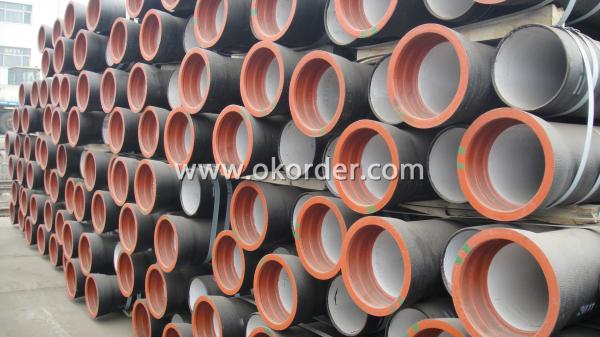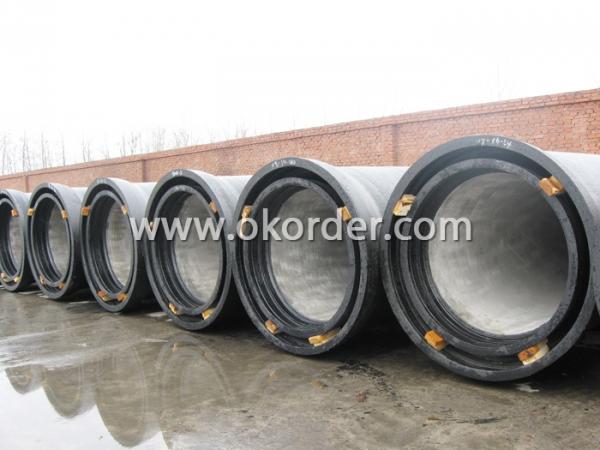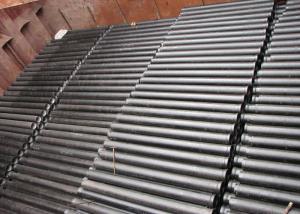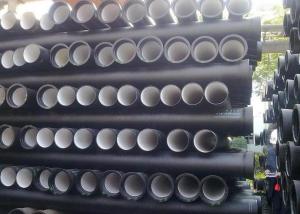ISO2531 Socket Spigot Ductile Iron Pipe K8
- Loading Port:
- China Main Port
- Payment Terms:
- TT or LC
- Min Order Qty:
- 100 Meter m
- Supply Capability:
- 250000 Ton Per Year m/month
OKorder Service Pledge
OKorder Financial Service
You Might Also Like
General Introduction and Specifications of ISO2531 Socket Spigot Ductile Iron Pipe K8
Standard: Pipes according to ISO2531/EN545
Joint: T Type joint
Size: DN80-DN2000
Effective length: 6m/pc or 5.7m/pc or 5.5m/pc
Internal lining: cement mortar lining comply with ISO4179
External coating: sprayed metallic Zinc coating (min.130g/m2) according to ISO8179 + bitumen painting (min.70μm) according to BS3416.
Gasket: Matched 100% natural rubber gasket in accordance with ISO4633.
Applications of ISO2531 Socket Spigot Ductile Iron Pipe K8
Design Flexibility: Pipes will safely function over a wide range of operating pressure, trench loads and installation conditions. Standard design includes generous factor of safety to protect against unknowns.
Easier Handing: Ductile Iron Pipes can be more easily maneuvered under and around existing underground obstructions, thereby eliminating unnecessary changes in line or grade.
Superior Joints: Easily assembled push in joints speed job progress, minimize installation cost. Joint remains leakproof under all operating pressures.
A complete Range: Ductile Iron Pipes are available with complete range of fittings and accessories in size from 80 to 2000mm dia. And a variety of lining and coatings for varied service conditions.
Standard Wall Thickness of ISO2531 Socket Spigot Ductile Iron Pipe K8
Nominal Wall Thickness of pipe:
e=K(0.5+0.001*DN)
Where, DN: Nominal diameter; K: Coefficient(K=7,8,9,10,11,12...)
Nominal Wall Thickness of pipe fittings:
e=7+0.014*DN (K=14)
e=6+0.012*DN (K=12)
Packing, Delivery and transport of ISO2531 Socket Spigot Ductile Iron Pipe K8


Show for ISO2531 Socket Spigot Ductile Iron Pipes K8




- Q:Are ductile iron pipes suitable for road crossings?
- Yes, ductile iron pipes are suitable for road crossings. Ductile iron is a strong and durable material, making it well-suited for underground installations such as road crossings. The pipes have high tensile strength, which allows them to withstand heavy loads and traffic pressures without cracking or breaking. Ductile iron pipes also have excellent corrosion resistance properties, ensuring their longevity even in harsh environments. Additionally, these pipes are easy to install and maintain, making them a reliable choice for road crossings.
- Q:What is ductile iron pipe?
- The main components of ductile iron pipes are carbon, silicon, manganese, sulfur, phosphorus and magnesium. Execution standard GB/T13295-2003ISO2531/2003
- Q:Ductile iron pipes lined with cement mortar in the water (living water, water in the 6.9-7.3) in the early pH, why pH increased? How to solve this problem?
- 1, because of the bone in mortar, such as silicate products, there will be silicification reaction, in addition, there is the reaction of limestone in lime.2, cement mortar lining cover coating, that is, spray some paint! Some questions four are unavoidable
- Q:How are ductile iron pipes protected against abrasion or wear?
- Ductile iron pipes are protected against abrasion or wear through various methods, including external coatings and linings. These protective measures serve to create a barrier between the pipe's surface and any potential abrasive materials or fluids it may come into contact with. Additionally, the use of sacrificial anodes and cathodic protection systems can also help prevent corrosion and extend the lifespan of the pipes.
- Q:How to control mortar proportioning in ductile iron pipe cement coating
- The mix ratio of cement coated mortar for ductile iron pipes refers to the weight ratio of various raw materials consisting of ductile iron pipes and cement coated mortars.
- Q:Are ductile iron pipes suitable for high-temperature applications?
- No, ductile iron pipes are not typically suitable for high-temperature applications as they have a lower melting point compared to other materials like steel.
- Q:What is the expected leakage rate for ductile iron pipes?
- The expected leakage rate for ductile iron pipes can vary depending on various factors such as the age, condition, and installation methods of the pipes, as well as the quality of the materials used. However, ductile iron pipes are generally known for their durability and low leakage rates compared to other pipe materials. According to industry standards and research studies, the expected leakage rate for well-maintained ductile iron pipes can be as low as 0.1% per year. This means that, on average, less than 1 liter of water per meter of pipe length may leak annually. However, it is important to note that this is an average figure and actual leakage rates can vary. Regular maintenance and inspections play a crucial role in minimizing leaks and ensuring the longevity of ductile iron pipes. Additionally, proper installation techniques, such as using effective jointing methods and adequate bedding and backfill materials, can also contribute to reducing leakage rates. It is recommended to consult with industry professionals and adhere to applicable standards and regulations to determine the expected leakage rate for specific ductile iron pipe installations.
- Q:How does ductile iron pipe perform in areas with high groundwater levels?
- Ductile iron pipe performs exceptionally well in areas with high groundwater levels. One of the key advantages of ductile iron pipe is its corrosion resistance, which makes it highly suitable for underground applications and areas with high water tables. Unlike other materials, ductile iron pipe is not susceptible to rust or corrosion caused by groundwater, ensuring its durability and longevity. Furthermore, ductile iron pipe has excellent strength and flexibility, allowing it to withstand the external pressure exerted by high groundwater levels. It can resist the buoyant forces exerted by water, preventing it from floating or shifting out of place. In addition, ductile iron pipe's joints are tightly sealed, preventing any groundwater from infiltrating the pipe system. This ensures that there is no leakage or contamination of the water supply, which is crucial in areas with high groundwater levels. Overall, ductile iron pipe is the ideal choice for areas with high groundwater levels due to its corrosion resistance, strength, and ability to maintain a tight, secure system. It provides a reliable and long-lasting solution for water distribution and sewer systems, even in challenging environments.
- Q:What are the different types of fittings available for ductile iron pipe?
- There are several different types of fittings available for ductile iron pipe. These fittings are designed to connect, redirect, or branch off the pipe in various configurations to suit different plumbing or piping systems. One common type of fitting is the flanged fitting, which features a flange or lip on one end that allows for easy bolted connection to another flanged component. Flanged fittings are commonly used in applications where a tight seal is required, such as in water or sewage systems. Another type of fitting is the mechanical joint fitting, which utilizes a gasket and a set of mechanical bolts to create a secure connection between two pieces of pipe. Mechanical joint fittings are often used in underground water or sewer systems. Push-on fittings are another popular option for ductile iron pipe. These fittings have a rubber gasket that is compressed onto the pipe, creating a watertight seal. Push-on fittings are quick and easy to install, making them ideal for applications where speed and efficiency are important. For situations where a change in direction is required, ductile iron pipe fittings such as elbows or bends are used. These fittings are designed to smoothly change the direction of the pipe without causing any significant flow restrictions. Additionally, there are saddle fittings available for ductile iron pipe. These fittings are used to create a branch connection on an existing pipeline without the need for cutting or welding. Saddle fittings are commonly used in irrigation or fire protection systems. Overall, the different types of fittings available for ductile iron pipe provide a range of options to meet the specific needs of different plumbing or piping systems. Whether it's flanged fittings for a tight seal, mechanical joint fittings for underground applications, push-on fittings for quick installation, or specialized fittings like elbows or saddle fittings, each type serves a specific purpose in the overall plumbing or piping system.
- Q:How are ductile iron pipes connected?
- Ductile iron pipes are typically connected using several methods, including flanged joints, mechanical joints, and push-on joints. Flanged joints involve connecting two pipe sections with a flanged coupling. The pipe ends have flanges that are bolted together, creating a secure and leak-proof connection. This method is commonly used for larger diameter pipes or in applications that require a rigid joint. Mechanical joints utilize a mechanical joint gland and rubber gasket to create a watertight seal. The pipe ends are inserted into the gland, and the bolts are tightened to compress the gasket, ensuring a reliable connection. This method is often used in water distribution systems due to its flexibility and ease of installation. Push-on joints involve using a rubber gasket to create a tight seal between pipe sections. The gasket is placed in a groove on one pipe end, and the other pipe is pushed onto it, creating a compression seal. This method is quick and simple, making it suitable for various applications, including sewer systems and underground piping. Overall, the choice of connection method for ductile iron pipes depends on factors such as pipe diameter, application requirements, and installation conditions. It is crucial to follow the manufacturer's recommendations and industry standards to ensure proper installation and reliable performance.
1. Manufacturer Overview |
|
|---|---|
| Location | Shandong, China |
| Year Established | 1989 |
| Annual Output Value | Above US$ 3 Million |
| Main Markets | Mid East Europe; Eastern Asia; South Africa; |
| Company Certifications | ISO 9001:2008;ISO2531:2000 |
2. Manufacturer Certificates |
|
|---|---|
| a) Certification Name | |
| Range | |
| Reference | |
| Validity Period | |
3. Manufacturer Capability |
|
|---|---|
| a)Trade Capacity | |
| Nearest Port | Tianjin; Qingdao |
| Export Percentage | 41% - 50% |
| No.of Employees in Trade Department | 2000 People |
| Language Spoken: | English; Chinese; Spain; Alabic |
| b)Factory Information | |
| Factory Size: | Above 100,000 square meters |
| No. of Production Lines | Above 8 |
| Contract Manufacturing | OEM Service Offered; Design Service Offered |
| Product Price Range | Average |
Send your message to us
ISO2531 Socket Spigot Ductile Iron Pipe K8
- Loading Port:
- China Main Port
- Payment Terms:
- TT or LC
- Min Order Qty:
- 100 Meter m
- Supply Capability:
- 250000 Ton Per Year m/month
OKorder Service Pledge
OKorder Financial Service
Similar products
New products
Hot products
Related keywords


























